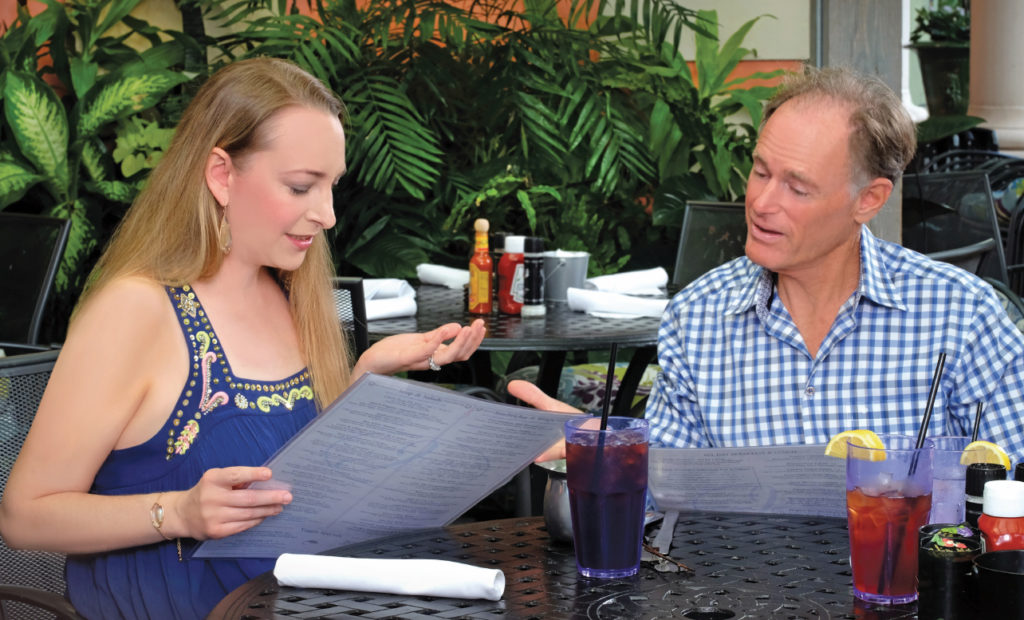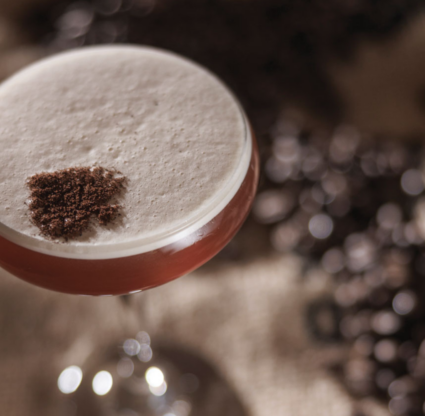Hi. I’m Dorothea. And I’m addicted to food—I plan my days around it, I dream about it, and I can’t refuse a bite of pretty much anything.
As the food and wine editor of this magazine, my professional livelihood also depends on it.
While I’ve definitely tried to health-up my diet as I’ve gotten older and slightly wiser, I can’t help being an equal opportunist when it comes to cravings. I could easily go for a bacon blue cheeseburger with crinkle-cut fries for lunch followed by a sous-vide duck with foie gras panna cotta for dinner.
But now, I’m a frazzled half of a parenting duo in charge of a 2-year-old daughter who runs circles around us. With waning energy levels and more “mom brain” moments than I’d like to admit, I was drawn to the work of Dr. David Perlmutter. A board-certified neurologist, fellow of the American College of Nutrition and local celebrity in Naples, he is known for his against-the-grain approach to medicine, spending much of his career focused on how nutrition affects your brain. He has written four books that were fixtures on The New York Times Bestsellers list, he has been a regular guest on The Dr. Oz Show, and his new PBS special that debuted in February, Dr. Perlmutter’s Whole Life Plan, is his third with the broadcaster.
I read his two seminal works, Grain Brain and Brain Maker, and had a general understanding of his thoughts on how people should eat: Fat, vegetables and probiotics = good; carbs = bad; gluten = selling your soul to the devil. But I invited him out for a series of breakfasts to see how it’d shake out in practice. Could I bend his rules around my lifestyle, or at the very least learn a thing or two?
DATE 1: BONITA BRUNCH
We started at this new restaurant on U.S. 41 on a Monday morning. I’m not one to leave brunching to the weekend.
The waitress talked a good game of a killer avocado toast, but I wanted to go for a real splurge, like how I’d unwind if I were there with my family. More importantly, could Perlmutter sanction an occasional indulgence?
“I’ll have the chicken and waffles with a side of sausage gravy,” I said. I convinced myself the gravy was necessary because breakfast out minus sausage or bacon just didn’t feel right.
Perlmutter scanned the menu and quickly picked something as well: “I’ll take an omelet with feta and spinach.”
Our waitress, as sweet as the syrup poured over my waffles, insisted on bringing him a side when he declined potatoes and toast. Another reflective gaze, and he asked if they could make sautéed spinach with olive oil.
The cogs in my head were turning as I processed that exchange. I was rusty on Grain Brain. I got the spinach, but whole eggs and cheese?
“Every cell in your body loves to burn fat as opposed to sugar, especially your brain,” Perlmutter explained, taking a sip of the whole-milk cappuccino he had ordered. “The human requirement for carbohydrates is 0 grams per day. … None. Whereas we have a defined fat requirement and a protein requirement. We also have requirements for various trace minerals and some vitamins. But having said that, the very important prebiotic fiber that we need is in complex carbohydrates—various vegetables—so there is a difference between complex carbohydrates and simple sugars.”
The way Cuba Gooding Jr. became famous for “Show me the money,” Perlmutter is on track for his axiom “Fat is your friend.” Most are aware of the plethora of evidence supporting the role of fatty acids found in fish with brain health. But Perlmutter argues nearly all fats both serve that purpose and make you feel fuller faster—hence the whole eggs, whole milk, feta and olive oil. He says it’s high time we embrace fat-laden yolks, which are loaded with antioxidants and amino acids that reduce inflammation (the link to a host of degenerative diseases).
As our meals arrived, I cautiously dug in, but I needed to ask: Is it OK to cut loose every now and then?
“Your body doesn’t know it’s your birthday or weekend brunch—or a Monday fun-day, for that matter. Did you see how everyone oohed and ahhed as your plate was being delivered? Everything that is wrong with the American diet today is on that plate, but it’s what people want. You’ve got chicken that’s been dipped in batter and deep-fried, the highly refined carbs in the waffles will send your blood sugar levels skyrocketing, and I haven’t started on the syrup. This is the most physiologically damaging breakfast you could have,” he hammered out.
But I like an occasional Monday fun-day, and there’s never been a birthday cake I’ve passed up. Then again, I realized this was coming from someone with the discipline not to celebrate his own birthday or who would stick a candle in a piece of watermelon.
But I saw his point.
“Just look at that label,” Perlmutter said, handing me the sticky jug of syrup. “The front clearly says ‘No high-fructose corn syrup,’ so a restaurant owner or the average American thinks, ‘Oh, that’s good.’ But flip it around, and what is the first ingredient? Corn syrup. It’s not high-fructose, but it’s still sugar by another name.”
Besides the fact nothing came from a tree in Vermont, it raised the bigger issue of how we’re eating way more calories than we need from sugar and how it spikes insulin production and overtaxes the liver. It also begged the point that a splurge here and there is a slippery slope that can fast give way to a landslide.
DATE 2: JANE’S ON 3RD GARDEN CAFÉ
Next, we hit this quintessential breakfast and lunch spot in Old Naples. As we relaxed into a table on the quiet covered patio, I stared at the menu, more confused than Tweedle Dee or Tweedle Dum.
Eggs and cheese are OK, but what about ham, a notoriously processed meat? Ah, screw it. “I’ll take the Dr. Seuss omelet,” I told the waiter. It’s the one with spinach, mushrooms, goat cheese and ham.
“That’s a good choice,” said Perlmutter approvingly.
But then I ordered an iced coffee with skim milk, and I could see Perlmutter’s face twitch. Oh, boy.
He got a salad with grilled chicken and avocado, “hold the croutons.”
Why in the world did my coffee set off alarm bells?
It wasn’t the cup of joe (duh, as the vision of his whole-milk cappuccino danced in my head), but that when fat is extracted from milk, sugar levels rise—plus, again, the whole fat-makes-you-feel-full thing.
Perlmutter’s sugar thesis is more mainstream now, because in 2016 JAMA Internal Medicine published the tale of how Big Sugar paid off Harvard researchers in the 1960s to hide its negative health effects, setting up a chain of misleading reports and half-truths for decades. We also know through modern science that people can become addicted to sugar, much like a drug.
“You know why paying attention to GMOs is important, right?” he asked.
I felt like one of Socrates’ early disciples, who must have grasped at anything to avoid looking like a dunce in a philosophy debate. I had reported on food for years, known in my gut that organic and non-GMO was the way to go. But to my surprise, I couldn’t articulate why, beyond organic equaling no chemicals.
“It’s because when fruits and vegetables are genetically modified, it is done so that farms can spray Roundup on them (but not have the crop itself die). It gives them resistance to pesticides and herbicides, and those toxins are the problem,” Perlmutter said. Those chemicals alter the balance of bacteria in your microbiome, the population of bacteria in your gut.
If I were in a cartoon, a lightbulb would have magically popped over my head—this all made sense given that a lot of what Perlmutter has researched in recent years ties back to the microbiome. He and an increasing number of scientists believe that balance of the billions of good bacteria versus bad has an impact on nearly everything in your body—the digestive system, nervous system, immune system.
Think about how staples like wheat, soy and corn are sprayed if they’re not certified organic. And guess what animals feed on when not grazing untouched pastures? By eating organic meats, including processed ones like bacon or ham, you don’t have to be concerned about exposure to those chemicals.
Gluten, the much-maligned amalgamated protein prevalent in some of the (sigh) most tantalizing foods, aggressively aggravates the microbiome and causes inflammation, which is why it’s at the top of the Perlmutter hazard list. (Not to mention, gluten is found in key sugar sources.) Just a few bites of croutons can make your gut go haywire.
When our dishes came, mine was loaded with home fries and toast; I nervously pushed them aside.
“About half of your plate is good; the rest, no. Those carbs are going to make you feel sluggish. Just wait and see,” Perlmutter said.
But isn’t whole-grain pasta or whole-grain bread supposed to be better for us than Wonder Bread or baguettes?
No matter how “good” they may seem, sugar is sugar and gluten is gluten. And if you do manage to find bread without either, it’s still a complex carbohydrate with a relatively high glycemic index (the measure of how quickly blood glucose levels rise). “Check the sugar content of everything you buy at the grocery store—you’ll be astonished,” Perlmutter said. When pressed on sources of carbohydrates that he occasionally eats beyond vegetables and fruits, he said only low-to-no-sugar, gluten-free options like quinoa, beans and brown rice.
As if on cue, our waiter spun around with what looked like complimentary cocktails.
I looked longingly at the colorful glass with a tiny umbrella and wished I were blissfully unaware of its contents. But research is research, so I jumped in headfirst on the subject of alcohol. Perlmutter didn’t categorically dismiss it, although he feels a glass or two of red wine is better than white. Both are fermented, so they have good bacteria, but red wine also has resveratrol, a natural anti-inflammatory. But isn’t wine mostly carbs? Yes. However, much like vegetables, minerals and other properties are the outweighing factors.
DATE 3: FOOD & THOUGHT
Attempting to unearth what Perlmutter regularly eats brought us to one of his favorite places (mine, too), Food & Thought. The market and café bills itself as “militantly organic.”
Even though we were there in the afternoon, the kitchen threw us a bone and whipped up Perlmutter’s choice breakfast: “Farmer Rene’s,” a plate of scrambled eggs, half an avocado, a spoonful of black beans and a nest of sautéed kale with morsels of bacon and onion.
I was done pushing his starch buttons, so I experimented with fruits and veggies. I got both a “Berry Nice” dairy-free smoothie of banana, strawberries, blueberries, raspberries and apple juice and “The Doctor” drink of juiced celery, carrot, beet, ginger, lemon and parsley. I also ordered the vegan and gluten-free vegetable soup chock-full of chopped carrots, onions, green beans, potatoes and corn.
Thumbs up for the soup. But Perlmutter said it needed something—lots of olive oil. Glancing at my rounded waistline, I wasn’t sure that was the best move, but I went with it.
“As long as you’re (using) real, organic, extra-virgin olive oil, it not only will help your brain, but it will help you lose weight,” he said, pouring some over his kale and practically emptying the bottle into my bowl. “See—it will even taste better. People crave that unctuous feeling in their mouths from fat.”
The green USDA organic symbol is a sign you’re getting the right stuff. He warned of some olive oil companies “refining” it with additives and filters, or meshing it with other types of refined oils (some of the only unhealthy fats).
For a typical day, Perlmutter doesn’t eat until noon. He’ll often have eggs and averages about two playing-card-deck-size portions of protein daily (like chicken or fish), usually with salads to sop up—you guessed it—olive oil. He doesn’t snack but suggests nuts. He loves avocados and dandelion greens, knowing the former is a source of fat and the latter brims with prebiotic fiber to nurture gut bacteria. He supplements with daily prebiotic acacia root powder and a probiotic pill. For a treat? A square of intensely dark chocolate, a bit of fruit or a glass of red wine. He never touches soda and has written off artificial sweeteners because they wreak havoc on the microbiome.
What about my picks this afternoon—a juice and a smoothie?
“Look, I don’t want to say what these people are doing is bad because the whole mission of this place is fresh, healthy food. But with juice, you are getting servings of vegetables, but the good parts with the nutrients—the pulp, the skin—have been weeded out. And as for the smoothie, yes, everything is organic and natural, but it’s still loaded with sugar.”
His prescription? Rather than relying on them or açai bowls daily, as I confessed to, buy them sporadically.
THE AFTERMATH
After the final leg of what felt like our anti-eating tour, I knew I needed to give his lifestyle a shot. And so began my six weeks as a guinea pig.
I quit sugar cold-turkey. On the third night, I laid in bed jittery at 3 a.m., my heart racing while I frantically Googled sugar withdrawal. I can report now I’d likely bleed golden green from subsequent binging on olive oil and avocados. My husband thinks I’m nuts for breakfasting on vegetable soup or a blender full of ice, almond butter and veggies. But I can’t think of anything else that’s quick, easy and Perlmutter-sanctioned. (When my daughter is clinging to my leg and begging for a sing-along before school, cooking eggs is out of the question.)
I’ve ended up with a little more meat than is probably advised and a bit short on veggies. I’ve also defaulted to small daily doses of arguably “better” carbs (low in sugar and free of gluten, like brown rice, quinoa and ultra-dark chocolate).
I’ve not only survived, but also haven’t taken as many naps nor lost my train of thought as often. A huge bonus is that I am no longer constantly congested—and I’ve lost 7 pounds.
That’s not to say I don’t have an internal struggle at least once a day, and going out to eat can be torture. But if you’re determined, you find a way to make it work. I didn’t even break rank at LuLu B’s diner with a spinach-mushroom-tomato frittata, no potatoes or toast (I requested fresh spinach topped with tomatoes and avocado instead). Being at Barbatella, however, and resisting a rosemary focaccia from the bread basket, avoiding my usual plate of orecchiette and passing up a bowl of chocolate gelato turned me into the red-faced, squinty-eyed emoji.
So I’ve come up with some rules of my own.
Am I someone who can pass up a sliver of cake on her birthday, or anyone else’s for that matter? No.
Will I continue to stick to the plan as often as possible and settle for sideways glances at garlic knots, croque madames, General Tso’s chicken and peanut butter pie most of the time? Yes.
But I know if I want Jägerschnitzel in its breaded, fried, mushroom-cream-sauce glory or spaghetti carbonara (hey, at least it’s got egg yolks) once—or who am I kidding, twice—a week, I’ll go for it.
Both my body and my soul will thank me.





